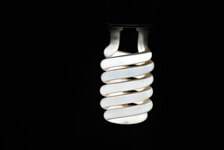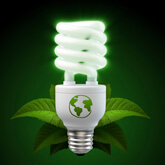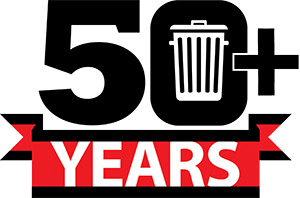Safely Disposing Your CFL Lights: What to do When You Break a CFL Bulb
 With traditional incandescent lights being phased out, and compact flourescent lights (CFL) being the most affordable alternative (next to halogen incandescents), it’s important to know how to properly dispose of a CFL bulb once it has burned out or is broken. CFL lights aren’t made out of the same materials that regular incandescent or LED bulbs are made of. In fact, a CFL bulb contains some of the following materials:
With traditional incandescent lights being phased out, and compact flourescent lights (CFL) being the most affordable alternative (next to halogen incandescents), it’s important to know how to properly dispose of a CFL bulb once it has burned out or is broken. CFL lights aren’t made out of the same materials that regular incandescent or LED bulbs are made of. In fact, a CFL bulb contains some of the following materials:- glass tubes
- phosphor coating
- mercury
- ceramic
CFL lights emit light when the mercury molecules become excited by electricity running between two electrodes in the base of the bulb. The mercury emits ultraviolet light, which then excites the tube's phosphor coating, leading it to emit visible light. Because CFL lights don’t produce light like incandescent bulbs, which produce light by heating the metal filament inside the bulb, they’re much more efficient. When electricity passes through the filament of an incandescent bulb, its temperature rises to 2,300 degrees Celsius, with the heat causing the filament to glow white-hot and emit light. But only 5 to 10 percent of that electricity is transformed into visible light. Because much less energy is wasted in a loss off heat, a CFL bulb is much more efficient.
CFL lights really can make a difference over time. According to EnergyStar—a program run by the Environmental Protection Agency—if each U.S. home replaced just one of its incandescent bulbs with a CFL bulb, the electricity saved each year could light 3 million homes and prevent greenhouse gas emissions equal to that of 800,000 cars. With studies from the U.S. government saying that a single 24-watt CFL bulb’s lifetime energy savings add up to the gas equivalent of a coast-to-coast Prius road trip, it's probably time to get moving on your energy footprint.
While the every and cost saving aspects of CFL lights is very appealing, it’s important to remember that they do contain hazardous materials and that they should be disposed of properly. If you have a broken CFL bulb, you should follow these steps according to the EPA’s website:
Before Cleanup
- Have people and pets leave the room.
- Air out the room for 5-10 minutes by opening a window or door to the outdoor environment.
- Shut off the central forced air heating/air-conditioning system, if you have one.
- Collect materials needed to clean up broken bulb:
- stiff paper or cardboard;
- sticky tape;
- damp paper towels or disposable wet wipes (for hard surfaces); and
- a glass jar with a metal lid or a sealable plastic bag.
During Cleanup
- DO NOT VACUUM. Vacuuming is not recommended unless broken glass remains after all other cleanup steps have been taken. Vacuuming could spread mercury-containing powder or mercury vapor.
- Be thorough in collecting broken glass and visible powder. Scoop up glass fragments and powder using stiff paper or cardboard. Use sticky tape, such as duct tape, to pick up any remaining small glass fragments and powder. Place the used tape in the glass jar or plastic bag. See the detailed cleanup instructions for more information, and for differences in cleaning up hard surfaces versus carpeting or rugs.
- Place cleanup materials in a sealable container.
After Cleanup
- Promptly place all bulb debris and cleanup materials, including vacuum cleaner bags, outdoors in a trash container or protected area until materials can be disposed of. Avoid leaving any bulb fragments or cleanup materials indoors.
- Next, check with your local government about disposal requirements in your area, because some localities require fluorescent bulbs (broken or unbroken) be taken to a local recycling center. If there is no such requirement in your area, you can dispose of the materials with your household trash.
- If practical, continue to air out the room where the bulb was broken and leave the heating/air conditioning system shut off for several hours.
 Recycling your CFL lights is extremely important. It prevents the mercury from a broken CFL bulb from being released into the environment. CFL lights and other fluorescent bulbs often break when thrown into a dumpster, trash can or compactor, or when they end up in a landfill or incinerator. Also, there are other materials in a CFL bulb that can be reused. Recycling CFL lights and other fluorescent bulbs allows the glass to be reused, as well as other metals and other materials that make up CFL lights. Virtually all components of a CFL bulb can be recycled.
Recycling your CFL lights is extremely important. It prevents the mercury from a broken CFL bulb from being released into the environment. CFL lights and other fluorescent bulbs often break when thrown into a dumpster, trash can or compactor, or when they end up in a landfill or incinerator. Also, there are other materials in a CFL bulb that can be reused. Recycling CFL lights and other fluorescent bulbs allows the glass to be reused, as well as other metals and other materials that make up CFL lights. Virtually all components of a CFL bulb can be recycled.
Because of their hazardous nature, CFL lights are not accepted in regular trash or recycling bins. Instead, please take them to:
1015 East Chambers Street
Sioux Falls, SD 57104
Novak Sanitary Service offers residential recycling for other household items. Click here to see our list of accepted recyclable materials. If you have a question about an item that’s not listed on the website, please email us. Remember, Novak customers have the opportunity to earn rewards for recycling with our Recyclebank program. Click here to see how you can start earning rewards for recycling today!
Last Modified:




